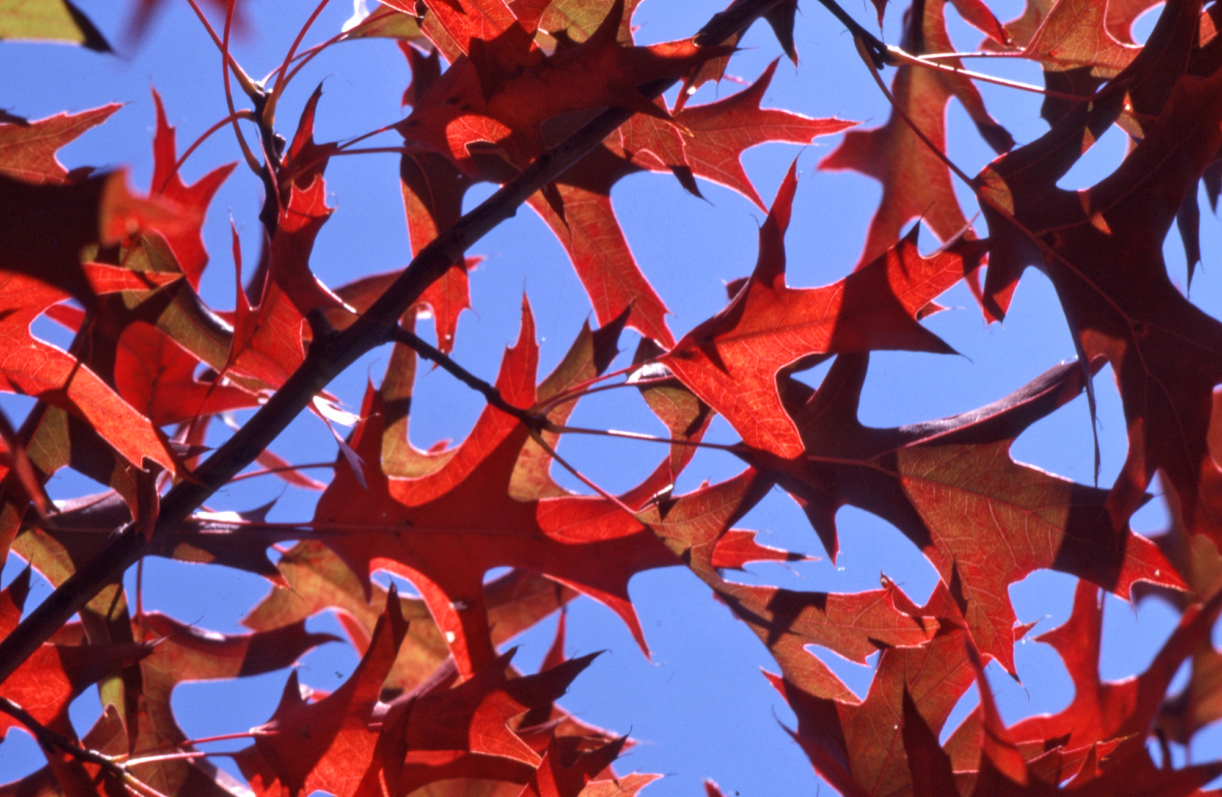Overview
As you enjoy the colors of autumn at The Morton Arboretum and in your neighborhood, many of the trees you will see are oaks.
Oaks are special to the Arboretum. It is home to one of the world’s finest public garden oak collections, and many of its scientific projects focus on oaks. The Arboretum’s Chicago Region Trees Initiative leads a special project to restore oak ecosystems in northeastern Illinois, while its Global Tree Conservation Program works to save threatened oak species around the world.
These trees are found in woodlands all over the Midwest and throughout many of the temperate regions of the world. “Oaks are the most ecologically valuable group of trees in North America,” said Murphy Westwood, PhD, the Arboretum’s vice president of science and conservation. They are considered keystone species—meaning that they are the foundation of ecosystems, supporting hundreds of species of insects such as butterflies and moths, birds such as blue jays, mammals including squirrels and chipmunks, and other plants such as the wildflowers that bloom in spring in the East Woods.
Here are some handsome oak species that you can find in the Oak Collection (Parking Lot 8). Several also grow in the East Woods along the trails from the Big Rock Visitor Station (Parking Lot 13), or along the sidewalks of your own community.
White Oak (Quercus alba)

This massive, long-lived, stately tree, with wide-spreading horizontal branches and wine-red fall color, is a common sight in the Chicago region. It is the state tree of Illinois, though its natural range extends all over the eastern United States. Large white oaks seen in yards or along sidewalks may date to the 19th century, and may have been growing before houses were there. White oaks can live more than 200 years, although sources of stress such as climate change, loss of habitat, and disease are leading many older oaks in the region to decline.
Bur Oak (Quercus macrocarpa)

The stately bur oak, with a huge trunk and broad branches, is native to prairies and savannas, the regions of scattered trees where prairie transitions to woodland. Its native range is around the Great Lakes, the Mississippi Valley, and the eastern Great Plains. A bur oak’s gray to brown furrowed bark is thick and corky—an insulating protection that evolved to protect the trees against lightning-strike prairie fires. Its lustrous dark green leaves turn yellow-brown in fall, and its huge acorns, with deep fringed caps, attract birds and small mammals.
Swamp White Oak (Quercus bicolor)

This striking tree, with orange-gold to yellow autumn leaves in mid-autumn, has attractive peeling bark, especially on young trees. In spring and summer, the lustrous, lobed leaves are dark green on top with a silver-white underside. Because it’s a lowland tree, adapted to floodplains, and it tolerates clay soil, swamp white oak is often planted in parkways and other urban sites that have conditions too difficult for many other kinds of trees.
Northern Red Oak (Quercus rubra)

The leaves of this Midwestern native tree are handsome throughout the year, emerging pinkish-red, turning lustrous dark green in summer, and changing to russet-red to bright red in autumn. The pointed lobes of its leaves are characteristic of the red oak group of oaks. Northern red oak tolerates salt and air pollution and grows relatively quickly.
Dwarf Chinkapin Oak (Quercus prinoides)

Not all oak species have the deeply lobed leaves Midwesterners associate with oaks. The leaves of dwarf chinkapin oak are smallish ovals, with an edge that is coarsely toothed and sometimes almost ruffled. They turn shades of red and orange in fall. This small tree or shrub has a native range more toward the Southeastern U.S. and prefers acid soils, which are not common in the Chicago region. A separate species that has similar leaves, chinkapin oak (Quercus muehlenbergii), is a larger tree more adapted to alkaline soil and is native to the Chicago region. Chinkapin is an Algonquian word for a kind of chestnut that also has similar leaves to the dwarf chinkapin oak.
Pin Oak (Quercus palustris)

Because of its attractive russet to red fall color, this oak is a popular choice for landscapes. Unfortunately, it is not adapted to the alkaline soil that predominates in the Chicago region, and in many sites it suffers greatly from chlorosis, or yellowing of the leaves. Pin oak should only be planted where testing has confirmed that the soil is acidic. It is a relatively fast-growing (though short-lived) oak, native to wet areas, especially along rivers.
Scarlet Oak (Quercus coccinea)

True to its name, the scarlet oak’s leaves turn a splendid scarlet in fall. Although it is native to parts of the Chicago region, most of its range is in the southeastern United States, especially the Appalachian Mountains. This large tree grows mainly in sandy, acidic soil; acid level in the soil should be tested before planting this species.
Shingle Oak (Quercus imbricaria)

Like chinkapin oak, shingle oak has very un-oak-like leaves, with no lobes and smooth edges. They turn russet brown and yellow in fall. Shingle oak is a medium-sized tree that prefers acid soil but can tolerate moderately alkaline conditions. The very hard wood of this Illinois native tree accounts for its name: Its logs were once commonly split for roof shingles.



